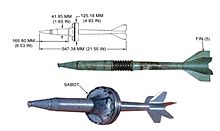Sabot (firearms)




A sabot /ˈsæboʊ/ is a device used in a firearm or cannon to keep a projectile, such as a bullet, in the centre of the barrel when fired. It has a smaller diameter than the bore diameter of the weapon used.
Design
Since a strong seal is needed to trap propellant gases behind the projectile, and keep the projectile centered in the barrel, something is needed to fill the undesirable but necessary gap between projectile and barrel, a space referred to as the windage, and this is the role of the sabot. Firing a small-size projectile wrapped in a sabot raises the muzzle velocity of the projectile. Made of some lightweight material (usually plastic in smallbore guns, and aluminium – and, in earlier times, wood or papier-mâché – in cannons), the sabot usually consists of several pieces held in place by the cartridge or a loose connection. When the projectile is fired, the sabot blocks the gas, and carries the projectile down the barrel. When the sabot reaches the end of the barrel, the shock of hitting still air pulls the parts of the sabot away from the projectile, allowing the projectile to continue in flight.
Sabots are used to fire the flechettes that form anti-armour kinetic energy penetrators. This round consists of the outer cup (sabot) which holds numerous subcaliber darts. The sabot cup holds the individual flechettes together tightly until the sabot case separates after leaving the barrel. For reasons why a smaller diameter projectile can be desirable, see external ballistics and terminal ballistics.
Sabot-type shotgun slugs were marketed in the United States starting in about 1985. When used with a rifled slug barrel, they offer vastly improved accuracy compared to traditional shotgun slugs. They are now legal for hunting in most U.S. states.
Types of sabots

1. Cup type sabot
2. Expanding cup sabot
3. Base sabot
4. Spindle sabot
5. Ring sabot

Cup sabot
A cup sabot merely supports the base and rear end of a projectile. When the sabot and projectile exit the muzzle of the gun, air pressure on the sabot forces the sabot to release the projectile.
Expanding cup sabot
Used typically in small arms (most commonly muzzleloaders), an expanding cup sabot has a one piece sabot surrounding the base and sides of a projectile. Upon firing, when the sabot and projectile leave the muzzle of the gun, inertia from the rotation of the projectile and sabot opens up the segments surrounding the projectile, releasing it.
Base sabot
A base sabot has a one piece base which supports the bottom of the projectile, and separate pieces that surround the sides of the projectile and center it.
The base sabot has better and cleaner sabot/projectile separation than cup or expanding cup sabots, but is more expensive since more pieces are involved.
Spindle sabot
A spindle sabot uses a set (usually two) of matched rings which have a center section in contact with a long projectile, front sections which center that projectile in the barrel, and a rear section which both centers the projectile and seals propellant gases.
Spindle sabots are the standard western type of armor-piercing ammunition. Two- and three-piece spindle-type sabots are shown in the illustrations at the right of this paragraph.
Shotgun slugs often use a cast plastic sabot similar to the spindle sabot. Shotgun sabots in general extend the full length of the projectile and are designed to be used in rifled barrels.
Ring sabot

A ring sabot uses the rear fins on a long projectile to help center the projectile, and the multi-piece sabot forms only a single thin ring around the projectile near the front, sealing gases from escaping past it and centering the front of the projectile.
Because the rear fins have to have the same diameter as the gun bore, they typically are larger than is optimum for flight performance.
Several Soviet and current Russian design armor-piercing sabot projectiles use ring sabots.
See also
- Shell (projectile)
- Armour-piercing discarding sabot
- Gas check
- Obturate
- Saboted Light Armor Penetrator (SLAP)
